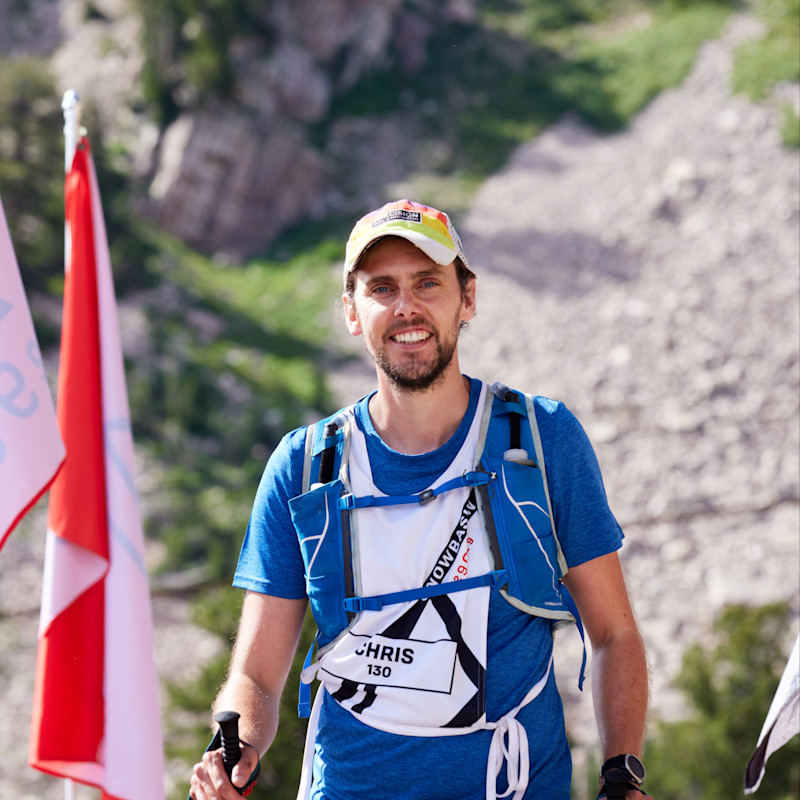
Chris Knight
29029 Snowbasin #1
Chris' headline numbers
Chris' strategy
Fueling
Carbohydrate is the main fuel you burn when racing. Failing to fuel properly is a leading cause of underperformance in longer races.
The 29029 Snowbasin #1 challenge involved hiking up a mountain thirteen times to reach the equivalent height of Mount Everest (i.e. 29029 feet), so Chris tried to largely rely on sports nutrition products to fulfill his fueling requirements during hikes. By consuming PF 30 Gels and PF 30 Chews during each 1.5 to 2 hour hike, Chris took more fuel on board (~45-60g/h) when he was moving at a higher intensity to keep his energy levels up. Between hikes, Chris took advantage of the real foods on offer at lunch, dinner and breakfast to consume the other macronutrients of fats and protein, which can be crucial during an event that involves such an extreme duration, whilst he was also careful to control his portion sizes so he didn’t overload his gut.
Hydration
Taking on board an appropriate amount of fluid and sodium is essential to maintaining blood volume and supporting the cardiovascular effort needed to perform on race day.
Whilst the absolute amount of sodium and fluid consumed per hour is important, it’s critical to consider these in relation to each other. This is known as 'relative sodium concentration' and it’s expressed in milligrams per litre (mg/L). How much sodium you’re taking in per litre of fluid is more important than the absolute amount taken in per hour.
Sweat sodium concentration (mg/L) is largely genetically determined and remains relatively stable. Knowing how salty your sweat is enables you to replace a good proportion of your sweat losses, which can range from 200-2,000mg/L.
Whilst Chris’s losses are on the low side, getting his hydration strategy right is still crucial when it’s hot and/or humid as his higher sweat rate in these conditions can result in significant net losses over the duration of a race.
Learn moreChris effectively used two 500ml soft flasks throughout the event which he filled up ahead of each hike, one with plain water and the other with PH 1000 Electrolytes. This allowed Chris, who’s classified as a ‘low’ salt sweater, to replace a good proportion of his sweat sodium losses. Chris’ fluid intake seemed adequate for this event, but he increased his intake during the hottest parts of the day (highs of 36°C/97°F!) to 1L/32oz per hour, which he thinks in hindsight may have been too much. In future, collecting more specific sweat rate data to give him an idea of the volume of sweat he loses in a variety of environments and intensities would be helpful. Overall Chris did well to listen to his body, change his approach during the hotter hours, and avoid any major hydration-related issues.
Caffeine
Beyond the Three Levers of Performance (carb, sodium and fluid), caffeine is one of only a few substances that is proven to improve performance for most endurance athletes as it can help stave off mental and physical fatigue.
Chris could have considered using slightly more caffeine during the waking hours of the event to reach the recommended caffeine guidelines in an attempt to help increase his perceived energy levels. This said, Chris told us that he was conscious of getting some good quality sleep (which he achieved!) and was worried that caffeine would have a negative impact on this.
How Chris hit his numbers
Here's everything that Chris ate and drank on the day...
Chris' weapons of choice
Final thoughts
Chris' full stats
Data Confidence?
There is an adequate level of accuracy in the data collected and the numbers reported. The athlete manages to recall what they ate and drank including most specifics (brands flavours quantities plausible estimations of volumes). However there are estimations made within the data which affect the overall confidence level in the data reported.